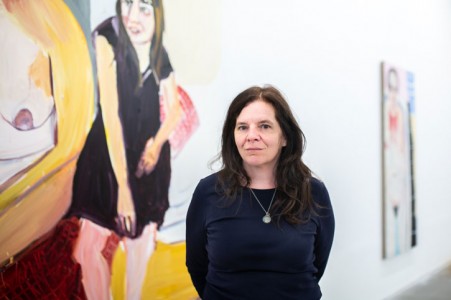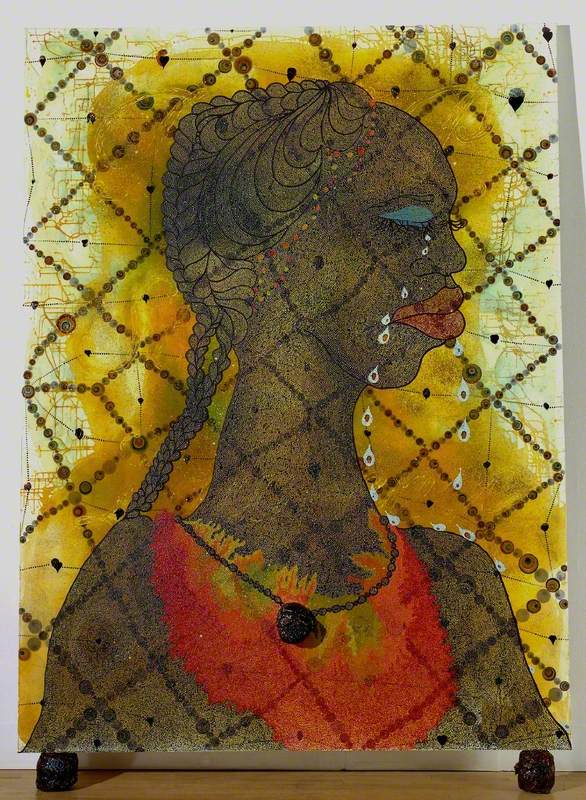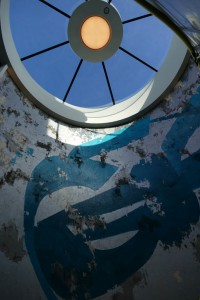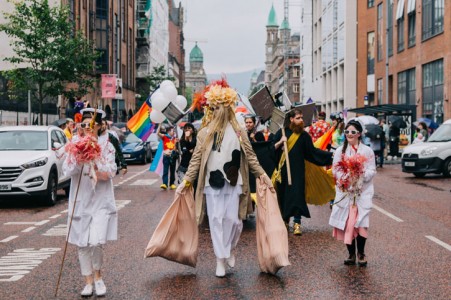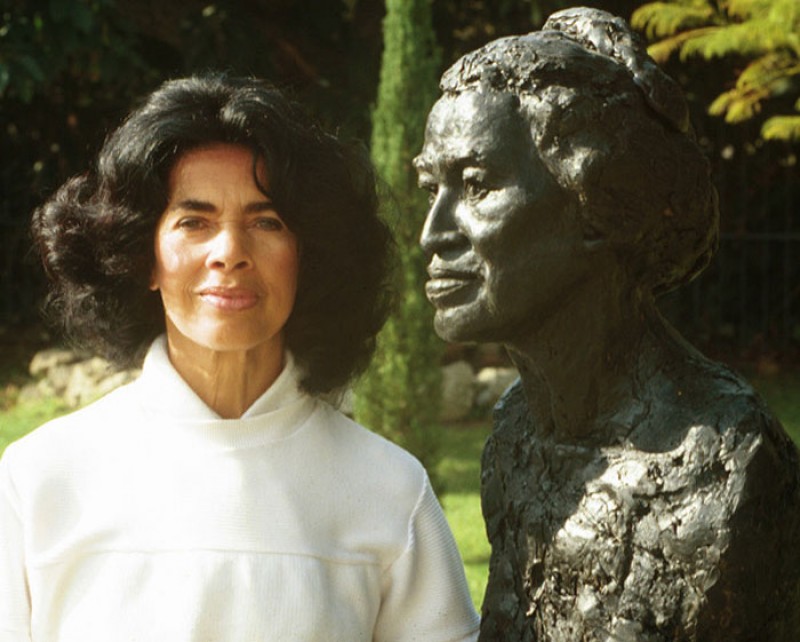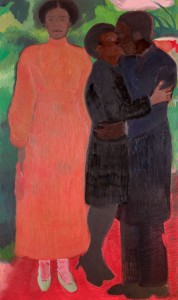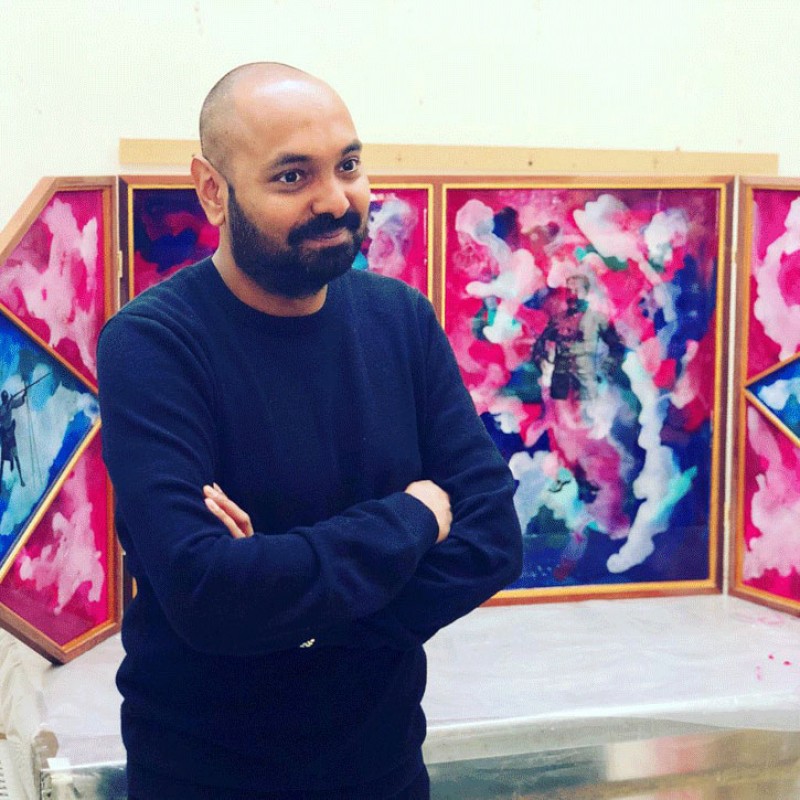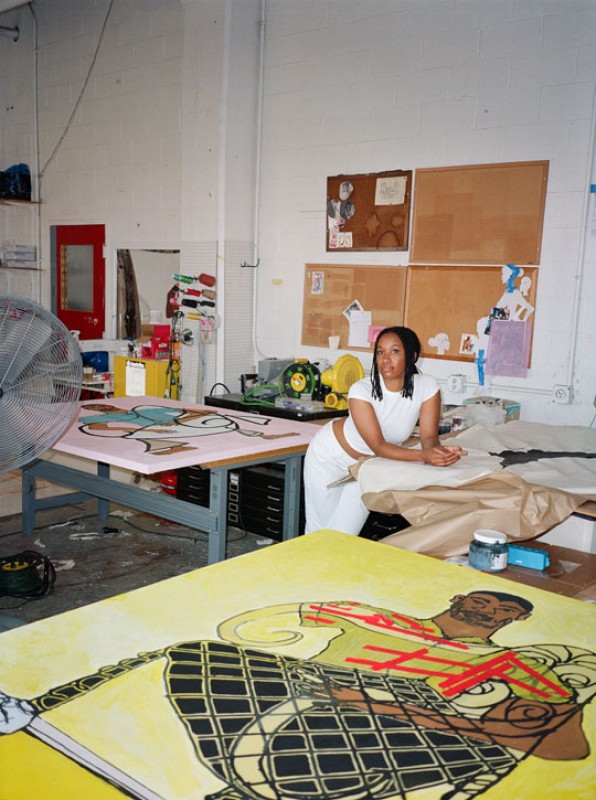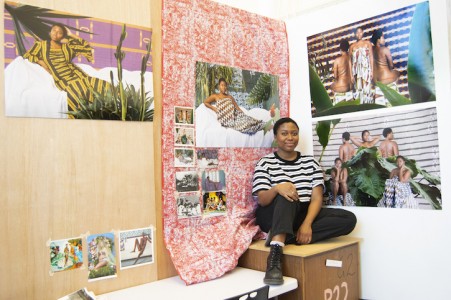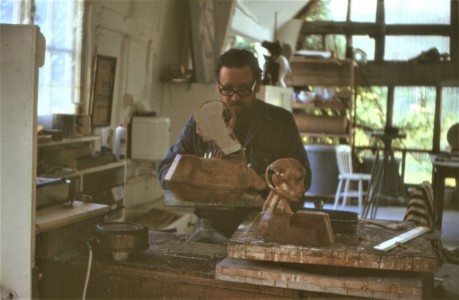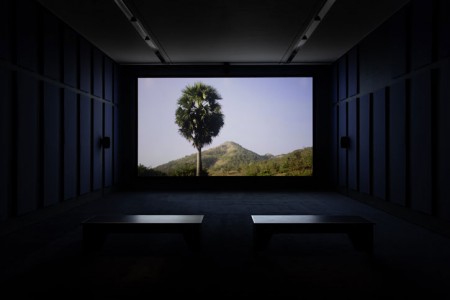In the series 'Seven questions with...' Art UK speaks to some of the most exciting emerging and established artists working today.
Since graduating from the Slade School of Art in 2017, Alvaro Barrington has charted a meteoric rise through the art world, becoming known for works that draw on disparate sources across art history (the artist is frank about his artistic inspiration), pop culture, music and politics. This expansive approach rests on a dizzying array of references, taking in everything from Tupac, Rihanna and Marcus Garvey to James Bond and Joseph Beuys.
While Barrington considers himself primarily a painter, his work examines the possibilities of that medium by experimenting with a range of materials – from yarn and burlap to concrete and wood.
Alvaro Barrington
Born in Venezuela and raised between the Caribbean and New York, Barrington is also alert to the histories of cultural production and exchange in these various locations. The Caribbean, in particular, exerts a huge influence on the artist, with many of his works making use of specific motifs – banana leaves, hibiscus flowers, yams – that connect with his heritage. But no less central is the 1980s Brooklyn of his youth, especially the music from that era.
For his current exhibition 'Alvaro Barrington: Spider The Pig, Pig the Spider' at South London Gallery – his first major solo show in a UK institution – Barrington characteristically unites a vast number of references, including Orwell's Animal Farm, Peppa Pig, video games and Louise Bourgeois' spider sculptures. An installation divides the gallery into the global North and South – a way for Barrington to reflect on the inequalities between the two – and a new body of work engages with the ways in which the digital increasingly impacts upon our lives.
I spoke to Barrington ahead of his South London Gallery show about augmented reality, making art in the information age, and why rules are there to be broken.
Imelda Barnard: You've created a site-specific installation for your solo show at South London Gallery. How have you approached the architecture of the space?
Alvaro Barrington: When I started building the installation, it was a little misleading because the gallery ceiling is so high. You think you have so much space but then it's actually not that huge in terms of length. Engaging with the height was really important. I had a lot of ideas – I was especially influenced by the Kai Althoff exhibition at Whitechapel Gallery (7th October 2020 to 12th January 2021). He used plastic sheeting so that the huge main gallery at Whitechapel that's difficult to deal with became much lower and a more manageable height. Sometimes his paintings are really intimate. He built a home for his work.
Alvaro Barrington, installation view
I've dealt with the height of the gallery space by placing paintings high up. I've created a skyline and there are some cloud paintings that are right before you meet the actual clouds. And then there's the history of great English painters such as J. M. W. Turner or James McNeill Whistler who dealt with looking at nature. I wanted to make a homage to them.
Imelda: You often draw on art history – which other artists have influenced your approach to the exhibition? Do you think of yourself as working in a particular tradition?
Alvaro: While making my exhibition at South London Gallery, I thought a lot about Duchamp and the display of his works at the Philadelphia Museum of Art. Turner, the Abstract Expressionist school and Helen Frankenthaler are a big part of my DNA. I also reference Ellsworth Kelly – I was especially interested in the way he draws flowers, I love the simplicity – and Josef Albers. With Albers, it's about how his Homage to the Square draws you inwards. This helped me to figure out how to make the frames that I use in the show – for the frame to focus the viewer inwards.
In terms of working in a tradition, there are a lot of ways that artists can operate but I think the twenty-first century is the information age – we have access to everything. I don't know if I'd be doing my art any favours if I fell into a nineteenth-century way of thinking that you have your hero and then you just follow through with their thinking...
Imelda: A number of new paintings explore the digital realm. Did your experience of COVID-19, in particular the emphasis on the digital over the last 18 months, impact your thinking around the show?
Alvaro: When lockdown happened I thought that the universe was telling us to slow down. I took the time to stop and ask myself what was happening. So much of my painting previously responded to the physical world, whereas now it has to respond to the digital. I realised we were all now rushing towards the digital and that I needed to tackle this thing that so fully dictates the life of, say, my 16-year-old niece, of the world that she's going to be a part of.
Alvaro Barrington, installation view
The industrial revolution and the emergence of photography in the nineteenth century meant painting had a new set of pressures. The digital revolution that's happening now also means that painting will have a new set of pressures. It's also affected how a generation of people are seeing things. I was listening to a guy who worked at Google talking about where we might be in 20 years' time – about AI, Augmented Reality and self-driving cars. What happens in say, five years, when Google brings out AR glasses – people will be seen how they want to be seen; they'll be avatars of themselves. I think human beings have always been concerned with how we get to be seen – on Instagram, people use filters to present themselves. The human imagination offers so much possibility. Maybe you want to be Batman mixed with half a plant or some weird animal that you sketched up...
A new body of work at South London Gallery, on the lower walls, explores where we're going in digital terms, and how we're getting there. My experience is from the perspective of someone who is nearly 40 (Facebook arrived when I was in college). But what about a six-year-old born into this digital world? I thought it was more important to look at my own relationship to it, such as through playing Super Mario World with my cousin (Carib Series, Marioworld 2, Spider Pig, September 2021 depicts a map from the video game), or Grand Theft Auto, a game in which you can drive while listening to the radio. It reminded me of falling in love with different soundtracks, like Rick James or music from the 1980s. It's a preview of how the soundtrack of so many kids' lives will be formed through the video games they're playing. The sound of the future will have to be reimagined: if the videogame is the soundtrack then what does that sound like?
Alvaro Barrington, installation view
Imelda: You think of yourself as a painter (Barrington's work is currently included in 'Mixing it Up: Painting Today' at the Hayward Gallery), but your multimedia works often experiment with yarn, wood and textiles. What is your approach to materials?
Alvaro: They function in a number of ways but it's mostly about me thinking about their possibilities. I frequently use burlap and through that I think about the burlap sacks used in cocoa production, or Gauguin who painted on burlap, or the Arte povera artists. I'm tapping into something I've experienced but also how art history has thought about that material.
Some of the works on show at South London Gallery incorporate carpet, which I also experimented with earlier this year [for his exhibition 'You don't do it for the man, men never notice. You do it for yourself, you're the fucking coldest' at Thaddaeus Ropac, Paris, from 2nd March to 17th April 2021. In those works, I was thinking about the domestic – in particular the artist Mike Kelley and his use of carpet as a shorthand for the domestic. Like a lot of folks (my family are all working class so they all went to work), I was stuck at home during lockdown and so it became an obvious material. I also thought about how many kids paint on their parents' floors!
I don't think of the materials I use in non-traditional terms. Painting has existed for thousands of years and human beings have painted on whatever surface is available. Kids today are painting on iPads – that will soon become the traditional surface! There's often a lot of positioning around questions of hierarchy or tradition in art but when you look at the long history of the world you realise these hierarchies aren't really there. For me, the more you look, the more you realise there are no rules.
Alvaro Barrington, installation view
Imelda: You were born in Venezuela and raised between the Caribbean and New York. In what way is your work reflective of these geographies?
Alvaro: In the South London Gallery show, for example, one wall of the gallery represents the global North and the other the global South. Moving from the global South to North not only means changing location but also material conditions, or reflecting on what access to materials each region has. So some of the paintings are made on burlap or hessian, materials which are more accessible in South America, India, or the Caribbean. On the other side – the North – are paintings made onto Hermes blankets. The exhibition also reflects how homes are constructed. I've made frames from cement in the 'North', and frames made of corrugated metal in the 'South'.
I've used Caribbean motifs in other works (such as hibiscus flowers and yams) as a way of connecting with one part of my heritage, but they are also about ways of giving a shorthand to someone to say, 'I was thinking about you when I made this painting'. I'm an art nerd so if you throw paint around in a certain way then someone with knowledge of art history might say you're referencing Pollock. Painting a hibiscus flower becomes a shorthand for me to say that if you grew up in the global South or the Caribbean or Greece, then you'll have experienced that flower. I'm making a connection with the viewer – although I'm always placing certain motifs next to other things I'm bumping into or experiencing, such as aluminium, cement, or Rihanna...
Alvaro Barrington, installation view
Imelda: Your solo exhibition at MoMA PS1 in 2017 recreated your studio and featured notebook sketches, exhibition checklists and handwritten pieces of paper. Why is it important for you to reveal the process behind your work?
Alvaro: Because I make paintings as a way to think through ideas. I look at art in order to think about how artists see through things – and so that I can see better. For me, paintings are my way of processing something in the moment. But if you ask me what I thought 30 minutes ago I will probably have changed my mind! They're recordings of my ideas. Moving from idea to idea – that's kind of the plan.
Imelda: Do you have any particular studio rituals?
Alvaro: I have a ritual where I walk to the studio, get coffee and as I'm walking, I'm clearing my head. That's usually my morning routine. Music is also very important, it's about what kind of energy I want to get into – a song can really shift the way I'm feeling.
Imelda Barnard, freelance writer and editor
'Alvaro Barrington: Spider The Pig, Pig the Spider' is at South London Gallery, London, until 21st November 2021









